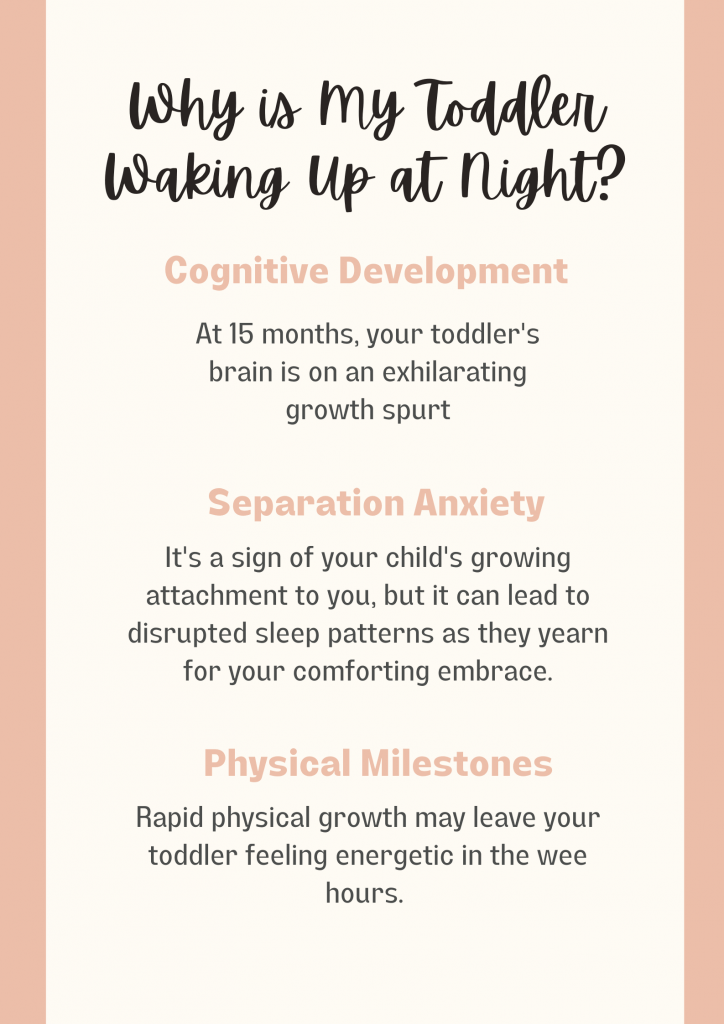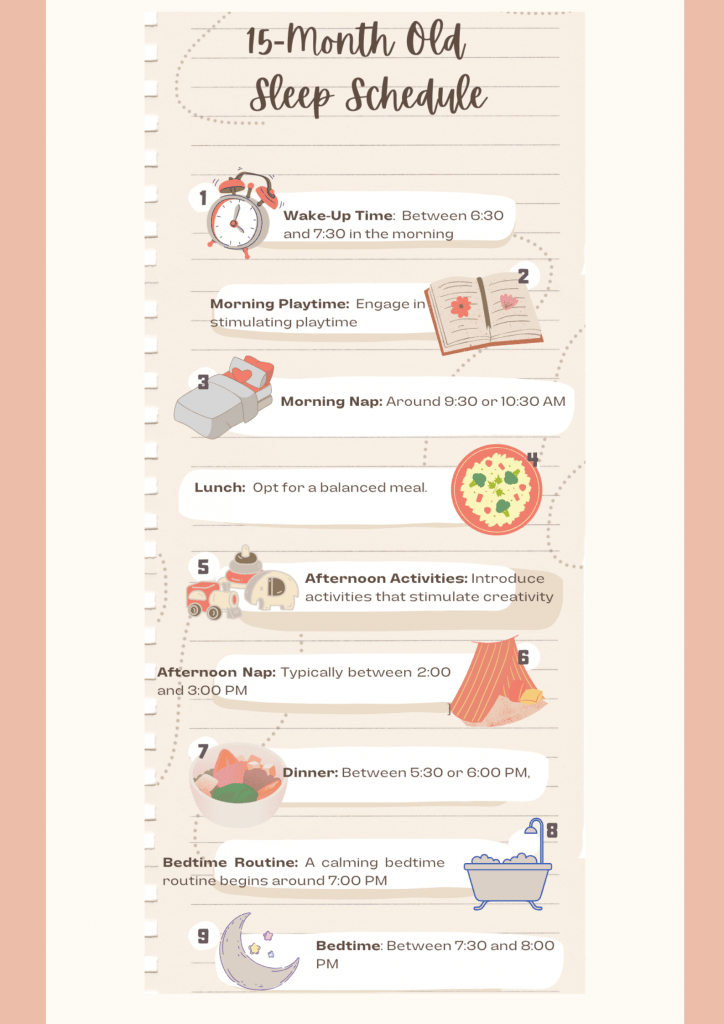Table of Contents
- The Crucial Role of Sleep in Child Development
- Why is My Toddler Waking Up at Night?
- How Long Does 15-month Sleep Regression Last?
- Can Sleep Regression happen at 14 and 16 Months?
- What’s a 15-Month Sleep Schedule Like?
- Unlocking the Sleep Secrets of Your 15-Month-Old
- Coping with 15-Month Sleep Regression
- Uncovering the Separation Anxiety and 15-month Sleep Regression Connection
- Navigating Night Wakings: A Roadmap to Restful Sleep
- When Do I Need to Bring My Toddler to the Doctor?
- Gentle Sleep Training at 15 Months
- A Restful Night is Coming
Picture this: your little one, who used to drift off to sleep quickly, is suddenly tossing, turning, and resisting bedtime. Nighttime wakings have become part of your daily routine, and those blissful moments of uninterrupted slumber feel like a distant memory. Fear not, for you are not alone in this bedtime battle. What you are experiencing is a well-known but perplexing phenomenon – the 15-month sleep regression.
In this guide, we will demystify this sleep hiccup. We will also arm you with strategies to navigate it confidently.
The Crucial Role of Sleep in Child Development
Now, why does sleep matter so much, especially for our kids? Well, it’s not just about getting some quiet time for parents (though that’s certainly a nice bonus). Sleep plays a vital role in your child’s growth and development.
During those precious hours of slumber, your child’s body is hard at work, repairing tissues, consolidating memories, and releasing growth hormones. But it’s not just the physical aspect; sleep is also crucial for cognitive development. While your child dozes off, their brain is busy organizing and processing all the information they’ve gathered during the day.
Children may struggle with concentration, problem-solving, and emotional regulation without enough sleep. So, when you’re knee-deep in a sleep regression battle, remember that you’re not just helping your child catch some Zzzs. You’re nurturing their potential, one peaceful night at a time.
Why is My Toddler Waking Up at Night?

It’s midnight, and you find yourself in a bleary-eyed stare-down with the baby monitor. You’re wondering why your toddler, who once slept through the night, is suddenly waking up. The culprit? Likely the 15-month sleep regression. But why does it happen?
Cognitive Development
At 15 months, your toddler’s brain is on an exhilarating growth spurt. They’re soaking up the world like a sponge, learning new skills, and quickly processing information.
While this cognitive development is thrilling, it can also stir up nighttime wake-ups. Their brains are too excited to hit the snooze button. They are too busy thinking about all the exciting things they’ve learned during the day.
Separation Anxiety
Around the 15-month mark, many toddlers develop separation anxiety. They’re becoming more aware of the world and, more significantly, of their separation from you.
Bedtime can suddenly feel like a scary farewell, and those midnight cries are often pleas for your reassuring presence. It’s a sign of your child’s growing attachment to you, but it can lead to disrupted sleep patterns as they yearn for your comforting embrace.
Physical Milestones
Teething, growth spurts, and newfound mobility can be a triple threat to peaceful nights. Those tiny teeth pushing through tender gums can bring discomfort. Meanwhile, rapid physical growth may leave your toddler feeling eenrgetic in the wee hours.
Additionally, when your little one discovers new ways to move around, they might want to practice their newfound skills in the middle of the night, causing those surprise wake-up calls.
How Long Does 15-month Sleep Regression Last?
The length of the 15-month sleep regression can be as unpredictable as a toddler’s taste in food. While the average duration falls between 2 to 6 weeks, it’s essential to recognize that every child is unique. Some may breeze through it in a few days, while others might linger in the regression’s grip for longer.
Variations among children are entirely normal when it comes to sleep regressions. Factors such as temperament, developmental milestones, and the strategies you employ to soothe your little one can all influence the duration. So, if your friend’s child sailed through this phase in a week while yours seems to take longer, know that it’s entirely typical.
The key is patience and persistence. Rest assured, the 15-month sleep regression is not a life sentence; it’s a natural part of your child’s development journey. As your little one’s cognitive, emotional, and physical growth progresses, their sleep patterns will eventually settle into a more familiar rhythm.
Can Sleep Regression happen at 14 and 16 Months?
Yes, it’s true; these sleep disturbances are not exclusive to the 15-month mark. Let’s explore what happens during these times and how they compare to the infamous 15-month sleep regression.
14-Month Sleep Regression: The Prelude to Independence
Around 14 months, your child may enter a mini sleep regression. It often sneaks in under the radar. What’s happening here is a preparation for newfound independence. Your toddler is on the brink of significant milestones, like walking and talking.
With these milestones comes an eagerness to explore the world, which can lead to increased restlessness and night wakings. Your toddler may be too excited about their newfound skills to settle for a peaceful night’s sleep.
16-Month Sleep Regression: The Adventure Continues
At 16 months, the sleep regression saga continues. By this age, your child’s curiosity knows no bounds. They’re exploring, experimenting, and asserting their independence in full force. This newfound sense of self can translate into more nighttime awakenings, as they may be testing boundaries and seeking reassurance from you.
Compared to the 15-month sleep regression, the 14- and 16-month regressions share common themes of increased restlessness, night wakings, and separation anxiety. However, the triggers and intensity can vary from child to child.
What’s a 15-Month Sleep Schedule Like?

As parents, we understand that establishing a consistent sleep schedule for your 15-month-old can seem like solving a complex puzzle.
Here’s a glimpse into what a typical day might look like for your toddler at this age. Do you know the magic ingredient that makes it all work – consistency?
Wake-Up Time: Your little one’s day usually kicks off between 6:30 and 7:30 in the morning. Of course, this can vary from child to child, so pay attention to their natural wake-up cues.
Morning Playtime: Your toddler is ready to conquer the world after a good night’s sleep. If possible, engage in stimulating playtime, explore books, toys, and even a little outdoor adventure.
Morning Nap: Around 9:30 or 10:30 AM, it’s naptime for your tired explorer. Most 15-month-olds still benefit from a morning nap that lasts 1 to 2 hours.
Lunch: Post-nap, it’s time for a well-deserved lunch, usually around noon. Choose a balanced meal that includes a mix of carbohydrates, proteins, and fruits or vegetables.
Afternoon Activities: The afternoon is ideal for more play and learning. You can introduce activities that stimulate creativity and fine motor skills, such as drawing, building with blocks, or simple puzzles.
Afternoon Nap: A short afternoon nap, typically between 2:00 and 3:00 PM, can recharge your toddler’s batteries for the remainder of the day.
Dinner: Between 5:30 or 6:00 PM, offer a nutritious dinner that mirrors lunch’s balanced approach.
Bedtime Routine: A calming bedtime routine begins around 7:00 PM. It may involve a warm bath, quiet reading time, lullabies, and cuddles. Establishing a consistent bedtime routine signals your child that it’s time to wind down and prepare for sleep.
Bedtime: Your 15-month-old usually drifts to dreamland between 7:30 and 8:00 PM. Putting them to bed at the same time every night is a cornerstone of a successful sleep schedule. It’s best to stick to it as closely as possible.
While every child is different, adhering to a daily routine can help regulate your toddler’s internal body clock, making bedtime and naps more predictable. Flexibility is vital, and adjusting the schedule to suit your child’s needs is okay.
Unlocking the Sleep Secrets of Your 15-Month-Old

Parents often ponder one of the most common questions: “How much sleep does my 15-month-old really need?” Well, the answer isn’t set in stone, but there are some general guidelines to help you navigate the world of toddler sleep.
On average, your 15-month-old should get around 12 to 14 hours of sleep in a day. It includes both nighttime sleep and daytime naps.
Nighttime Sleep: Your toddler typically needs to sleep uninterrupted for about 10 to 12 hours every night. However, it’s important to remember that individual variations are entirely normal. Some children may require more or less sleep to feel well-rested.
Daytime Naps: Daytime naps are still crucial at this age. Your 15-month-old should take one to two naps daily, lasting anywhere from 1 to 2 hours. The number and duration of naps can vary based on your child’s needs and sleep habits.
Taking Cues from Your Child
While these guidelines provide a helpful framework, paying attention to your child’s cues is essential. Every toddler is unique, and their sleep needs can differ. If your child is cheerful, alert, and thriving on the recommended amount of sleep, you’re on the right track. However, if they seem consistently overtired or restless, it may be a sign that they need more rest.
Coping with 15-Month Sleep Regression
Ah, the sleep regression phase – it’s a challenging rite of passage for both parents and toddlers alike. When your little one suddenly seems to forget the joys of uninterrupted slumber, it can leave you feeling lost and tired. But take heart, for there are strategies that can help you weather this storm.
Establish a Consistent Routine
Stick to a daily routine as closely as possible. A predictable schedule helps your toddler’s body and mind anticipate sleep, making bedtime and naps smoother.
Make Bedtime Calming
Crafting a calming bedtime routine is your secret weapon. It might include a warm bath, a cozy story, or gentle lullabies. A consistent pre-sleep ritual tells your child to wind down and prepare for slumber.
Stay Patient and Understanding

The 15-month sleep regression can test your patience, but remember, it’s just a phase. Your toddler may be grappling with new skills, emotions, or discomfort, and nighttime wake-ups are their way of seeking comfort. Approach these moments with understanding, offering the reassurance and love they need.
Prioritize Self-Care for Yourself, Too
Remember to care for yourself during this challenging phase. Sleep regressions can be emotionally taxing, and parents need to recharge. Seek support from family and friends, and don’t hesitate to take breaks when needed. A well-rested parent is better equipped to handle the nighttime hurdles.
Uncovering the Separation Anxiety and 15-month Sleep Regression Connection
Around the age of 15 months, many toddlers start to grasp the concept of being separate from their parents. This newfound awareness can trigger separation anxiety, which, in turn, can disrupt sleep. Your little one may resist bedtime, awaken in the middle of the night, or cry when left alone. These behaviors stem from a deep need for your presence and reassurance.
Strategies to Ease Separation Anxiety
What’s a parent to do? The key is acknowledging and addressing your child’s need for comfort while gently encouraging independence. One effective strategy is the introduction of transitional things, such as a blankie or a favorite stuffed animal. These cuddly companions offer a sense of security and familiarity when you’re not in the room.
Additionally, nurturing a consistent bedtime routine with plenty of snuggles, reassuring words, and a calm atmosphere can help your child feel safe and comforted.
Navigating Night Wakings: A Roadmap to Restful Sleep
When your little one starts waking up in the middle of the night during a sleep regression, it can be a puzzling and exhausting experience. The good news is that there are strategies to help soothe them back to sleep and minimize disruptions.
How to Soothe a Child Back to Sleep
First and foremost, responding to your child’s night wakings with comfort and reassurance is essential. Keep the environment calm and dimly lit, avoiding stimulating activities. Gently patting their back, softly singing a lullaby, or offering a comforting touch can work wonders.
Avoid picking your child up if possible, as this can create a habit of needing to be held to fall asleep. Instead, encourage self-soothing by gradually being less involved as you settle back to sleep.
Avoiding Engaging Activities During Night Wakings
While engaging in play or offering a snack during night wakings may be tempting, it’s best to keep interactions minimal. Engaging activities can signal to your child that it’s time to be awake and alert, making it harder for them to return to slumber. Stick to brief, soothing interactions and aim to keep the atmosphere as sleep-inducing as possible.
When Do I Need to Bring My Toddler to the Doctor?
Sleep regressions are a typical phase in a child’s development. It’s essential to recognize the differences between these temporary hiccups and potential sleep disorders. Here’s a guide to help you distinguish when it might be time to consult a pediatrician.
Sleep Regression vs. Sleep Disorder
Sleep regressions are typically short-lived disruptions in your child’s sleep patterns, often tied to developmental milestones, such as teething, cognitive leaps, or separation anxiety. They usually resolve on their own with time and consistent routines.
On the other hand, sleep disorders like insomnia, sleep apnea, or restless leg syndrome are persistent and recurring disruptions. They can significantly impact your child’s sleep and overall well-being. Signs to watch out for are chronic difficulty falling asleep, loud snoring,
Consulting a Pediatrician
Suppose your child’s sleep problems persist for an extended period, typically beyond the expected duration of a sleep regression. In that case, it’s advisable to consult a pediatrician. Additionally, if you notice concerning symptoms such as chronic loud snoring, gasping for breath during sleep, or long pauses in breathing, seek medical guidance promptly.
Pediatricians are well-equipped to evaluate your child’s sleep issues, rule out underlying medical conditions, and provide guidance on potential interventions or treatments if necessary. Trust your parental instincts; if you feel something is amiss or your child’s sleep problems are beyond the scope of a typical sleep regression, don’t hesitate to contact professional assistance.
Remember, your child’s well-being is paramount, and addressing sleep challenges can lead to better health and more restful nights for you and your little one. By staying vigilant and seeking timely medical advice when needed, you’re taking a proactive step toward ensuring your child’s sleeping habits are on the right track.
Gentle Sleep Training at 15 Months
The 15-month sleep regression can test even the most patient of parents, and you may wonder if sleep training is the solution. The good news is, yes, you can implement this method during this phase. However, it requires a gentle touch and responsiveness to your child’s needs. Here’s a roadmap to help you get started.
Understanding the Timing
While the 15-month sleep regression can disrupt sleep patterns, it’s often not the ideal time for the traditional “cry it out” tactic. Your toddler may be experiencing separation anxiety or discomfort, making a gentler approach more effective.
Using Gentle Sleep Training Methods
Gentle sleep training focuses on helping your child learn to fall asleep independently and eventually self-soothe. while providing comfort and reassurance. Consider the “Ferber method,” also known as “gradual extinction.” It involves gradually increasing the time between comforting visits to your child during nighttime awakenings.
Being Responsive to Your Child
One key element of gentle sleep training is responsiveness. When your child wakes up and cries, offer soothing words, gentle pats, or a reassuring presence. The goal is to help them settle back to sleep on their own while feeling secure knowing you’re nearby.
Consistency is Key
Consistency is the secret sauce of any sleep training method. Create a consistent bedtime routine and sleep schedule to help your child’s internal body clock adjust to a more regular sleep pattern.
Remember, every child is unique, and there’s no one-size-fits-all approach to sleep training. Pay attention to your child’s cues and adapt your methods as needed. Be patient and flexible, and don’t hesitate to consult with a pediatric sleep expert or seek support from parenting communities.
A Restful Night is Coming

The 15-month sleep regression is a common and often challenging phase for parents. Patience, consistency, and a steady sleep routine can be your armor in surviving this bedtime battle. Incorporating soothing bedtime rituals can also be your ally.
Remember that you need not walk this path alone. Seeking support is a powerful step. Lean on family, friends, or parenting communities for advice, reassurance, and a listening ear. Certainly, a parent or two (or maybe even more) has successfully overcome this phase in their child’s life.
Lastly, hold onto hope; this phase is temporary, a mere blip on the radar of your child’s development. As frustrating as it may be, it signifies growth, learning, and newfound independence. With your unwavering love and a support system in place, you’ll navigate the 15-month sleep regression with grace. You’ll emerge with the assurance that more restful nights await.











